An Analysis of the Business Environment and Kodak's Decline
VerifiedAdded on 2021/06/18
|10
|2441
|100
Report
AI Summary
This report provides a comprehensive analysis of the business environment in which Kodak operated, examining the key factors that contributed to its eventual decline. The report delves into the technological environment, highlighting Kodak's failure to adapt to the digital revolution and the rise of competitors. It also explores the international environment, including competition from companies like Fuji, and the economic environment, discussing financial challenges and the impact of changing market dynamics. Furthermore, the report investigates the legal environment, touching upon bankruptcy filings and strategic shifts. The analysis emphasizes the role of complacency, slow adaptation, and the failure to capitalize on innovation as major contributors to Kodak's downfall. The report underscores the importance of proactive management, employee involvement, and a focus on technological advancements for long-term business success, using Kodak's experience as a cautionary tale for companies in today's rapidly evolving market.

Running Head: BUSINESS ENVIRONMENT 1
BUSINESS ENVIRONMENT
Name
Institutional Affiliation
BUSINESS ENVIRONMENT
Name
Institutional Affiliation
Paraphrase This Document
Need a fresh take? Get an instant paraphrase of this document with our AI Paraphraser

BUSINESS ENVIRONMENT 2
Introduction
Business environment refers to the combination of internal factors and external factors
that affect business operation, and which can work together to improve or negatively affect the
business. Some of the internal factors include profits, management, current employees, corporate
culture, human resource, organizational structure, assets, loans etc. the external factors include
technology, competition, customers and suppliers, economy, politics, taxation, government
policies, etc. Internal factors are those factors controllable by the business itself because they are
from within the business whereas external factors are those that can’t be controlled by business
and it has totally no power over it(Soni & Kodali 2010). The success of a business depends on
these factors and it means, they can make or kill the business. The political instability which
affects economy may be good for some business and bad for others and vice versa. When an
economy of a country is doing badly the business may be at risk. The business owners and
managers must be very keen on ensuring that no internal factors have not been managed in order
to be at the safer side as they look into the environmental factors to act on their capacity since
they can’t control them(Soni & Kodali 2010). This essay will explore the environmental factors
in which Kodak film Company-operated and why it was able to fall in relation to four elements
of the business operation.
Technological environment
With the changing innovation and new discoveries in the film business which allowed
many goods and services to be offered to the consumers by other related companies, Kodak was
overwhelmed by rival companies that throw it out of the market. A company that employed over
60,000 employees in its peak in the 1980s failed to employ only 7000 people between 2004-2007
Introduction
Business environment refers to the combination of internal factors and external factors
that affect business operation, and which can work together to improve or negatively affect the
business. Some of the internal factors include profits, management, current employees, corporate
culture, human resource, organizational structure, assets, loans etc. the external factors include
technology, competition, customers and suppliers, economy, politics, taxation, government
policies, etc. Internal factors are those factors controllable by the business itself because they are
from within the business whereas external factors are those that can’t be controlled by business
and it has totally no power over it(Soni & Kodali 2010). The success of a business depends on
these factors and it means, they can make or kill the business. The political instability which
affects economy may be good for some business and bad for others and vice versa. When an
economy of a country is doing badly the business may be at risk. The business owners and
managers must be very keen on ensuring that no internal factors have not been managed in order
to be at the safer side as they look into the environmental factors to act on their capacity since
they can’t control them(Soni & Kodali 2010). This essay will explore the environmental factors
in which Kodak film Company-operated and why it was able to fall in relation to four elements
of the business operation.
Technological environment
With the changing innovation and new discoveries in the film business which allowed
many goods and services to be offered to the consumers by other related companies, Kodak was
overwhelmed by rival companies that throw it out of the market. A company that employed over
60,000 employees in its peak in the 1980s failed to employ only 7000 people between 2004-2007

BUSINESS ENVIRONMENT 3
according to New York Time’s story on Rochester’s economic evolution. Kodak in decades ago
had foreseen digital photography overtaking film which led to the latter inventing first digital
cameras in 1975 but decided to take critical chose to only focus on the legacy film business
leaving behind no improvement to its new discovery(Goldsborough 2013). Kodak was very
aware of the future but failed but failed to implement its strategies in to fit in it(Deaux & Gara
2013). This delay and ignorant cost the company beyond recover due to fast increasing
innovation by other related companies which never slept on their job. Henderson says, “Large
companies have a difficult time transitioning into new markets because there is a temptation to
put the existing asset into the new business.” New technologies allowing other companies new
methods of distributing goods and services was a big blow to Kodak. Kodak failed to change its
tactics to adapt to the new competitive markets(Lau 2014). Despite Kodak having so much
potential in coming with unique products and innovation, such as 1991introduction of photo CD,
allowing consumers to view digital photos on their computers, it was already decision got
slow(Lucas Jr & Goh 2009). In spite the company introducing many pocket-sized digital cameras
in the late 1990s and finishing with the introduction of EasyShare device in 2001, there was high
competition in the digital cameras market which offered even offered lesser prices. Innovation in
the smartphone technology has been other challenges which have faced the company with many
consumers preferring to iPhones which have richer features, Google Android devices for taking
videos and photos at an increased lower price. Although Kodak was very much aware of the
changing digital photography it decided to stick with its corporate culture which was too
ingrained in its past successes.
according to New York Time’s story on Rochester’s economic evolution. Kodak in decades ago
had foreseen digital photography overtaking film which led to the latter inventing first digital
cameras in 1975 but decided to take critical chose to only focus on the legacy film business
leaving behind no improvement to its new discovery(Goldsborough 2013). Kodak was very
aware of the future but failed but failed to implement its strategies in to fit in it(Deaux & Gara
2013). This delay and ignorant cost the company beyond recover due to fast increasing
innovation by other related companies which never slept on their job. Henderson says, “Large
companies have a difficult time transitioning into new markets because there is a temptation to
put the existing asset into the new business.” New technologies allowing other companies new
methods of distributing goods and services was a big blow to Kodak. Kodak failed to change its
tactics to adapt to the new competitive markets(Lau 2014). Despite Kodak having so much
potential in coming with unique products and innovation, such as 1991introduction of photo CD,
allowing consumers to view digital photos on their computers, it was already decision got
slow(Lucas Jr & Goh 2009). In spite the company introducing many pocket-sized digital cameras
in the late 1990s and finishing with the introduction of EasyShare device in 2001, there was high
competition in the digital cameras market which offered even offered lesser prices. Innovation in
the smartphone technology has been other challenges which have faced the company with many
consumers preferring to iPhones which have richer features, Google Android devices for taking
videos and photos at an increased lower price. Although Kodak was very much aware of the
changing digital photography it decided to stick with its corporate culture which was too
ingrained in its past successes.
⊘ This is a preview!⊘
Do you want full access?
Subscribe today to unlock all pages.

Trusted by 1+ million students worldwide
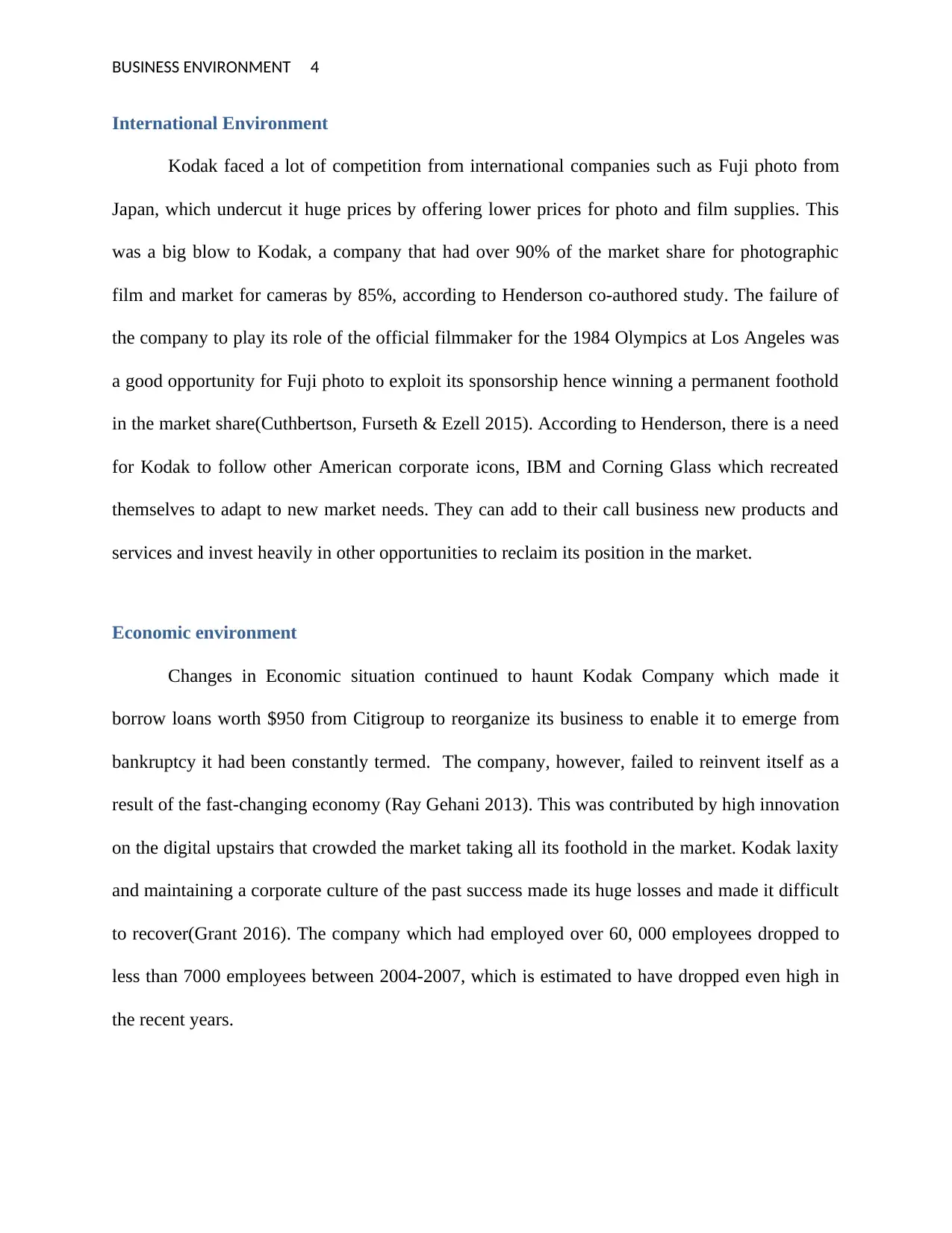
BUSINESS ENVIRONMENT 4
International Environment
Kodak faced a lot of competition from international companies such as Fuji photo from
Japan, which undercut it huge prices by offering lower prices for photo and film supplies. This
was a big blow to Kodak, a company that had over 90% of the market share for photographic
film and market for cameras by 85%, according to Henderson co-authored study. The failure of
the company to play its role of the official filmmaker for the 1984 Olympics at Los Angeles was
a good opportunity for Fuji photo to exploit its sponsorship hence winning a permanent foothold
in the market share(Cuthbertson, Furseth & Ezell 2015). According to Henderson, there is a need
for Kodak to follow other American corporate icons, IBM and Corning Glass which recreated
themselves to adapt to new market needs. They can add to their call business new products and
services and invest heavily in other opportunities to reclaim its position in the market.
Economic environment
Changes in Economic situation continued to haunt Kodak Company which made it
borrow loans worth $950 from Citigroup to reorganize its business to enable it to emerge from
bankruptcy it had been constantly termed. The company, however, failed to reinvent itself as a
result of the fast-changing economy (Ray Gehani 2013). This was contributed by high innovation
on the digital upstairs that crowded the market taking all its foothold in the market. Kodak laxity
and maintaining a corporate culture of the past success made its huge losses and made it difficult
to recover(Grant 2016). The company which had employed over 60, 000 employees dropped to
less than 7000 employees between 2004-2007, which is estimated to have dropped even high in
the recent years.
International Environment
Kodak faced a lot of competition from international companies such as Fuji photo from
Japan, which undercut it huge prices by offering lower prices for photo and film supplies. This
was a big blow to Kodak, a company that had over 90% of the market share for photographic
film and market for cameras by 85%, according to Henderson co-authored study. The failure of
the company to play its role of the official filmmaker for the 1984 Olympics at Los Angeles was
a good opportunity for Fuji photo to exploit its sponsorship hence winning a permanent foothold
in the market share(Cuthbertson, Furseth & Ezell 2015). According to Henderson, there is a need
for Kodak to follow other American corporate icons, IBM and Corning Glass which recreated
themselves to adapt to new market needs. They can add to their call business new products and
services and invest heavily in other opportunities to reclaim its position in the market.
Economic environment
Changes in Economic situation continued to haunt Kodak Company which made it
borrow loans worth $950 from Citigroup to reorganize its business to enable it to emerge from
bankruptcy it had been constantly termed. The company, however, failed to reinvent itself as a
result of the fast-changing economy (Ray Gehani 2013). This was contributed by high innovation
on the digital upstairs that crowded the market taking all its foothold in the market. Kodak laxity
and maintaining a corporate culture of the past success made its huge losses and made it difficult
to recover(Grant 2016). The company which had employed over 60, 000 employees dropped to
less than 7000 employees between 2004-2007, which is estimated to have dropped even high in
the recent years.
Paraphrase This Document
Need a fresh take? Get an instant paraphrase of this document with our AI Paraphraser
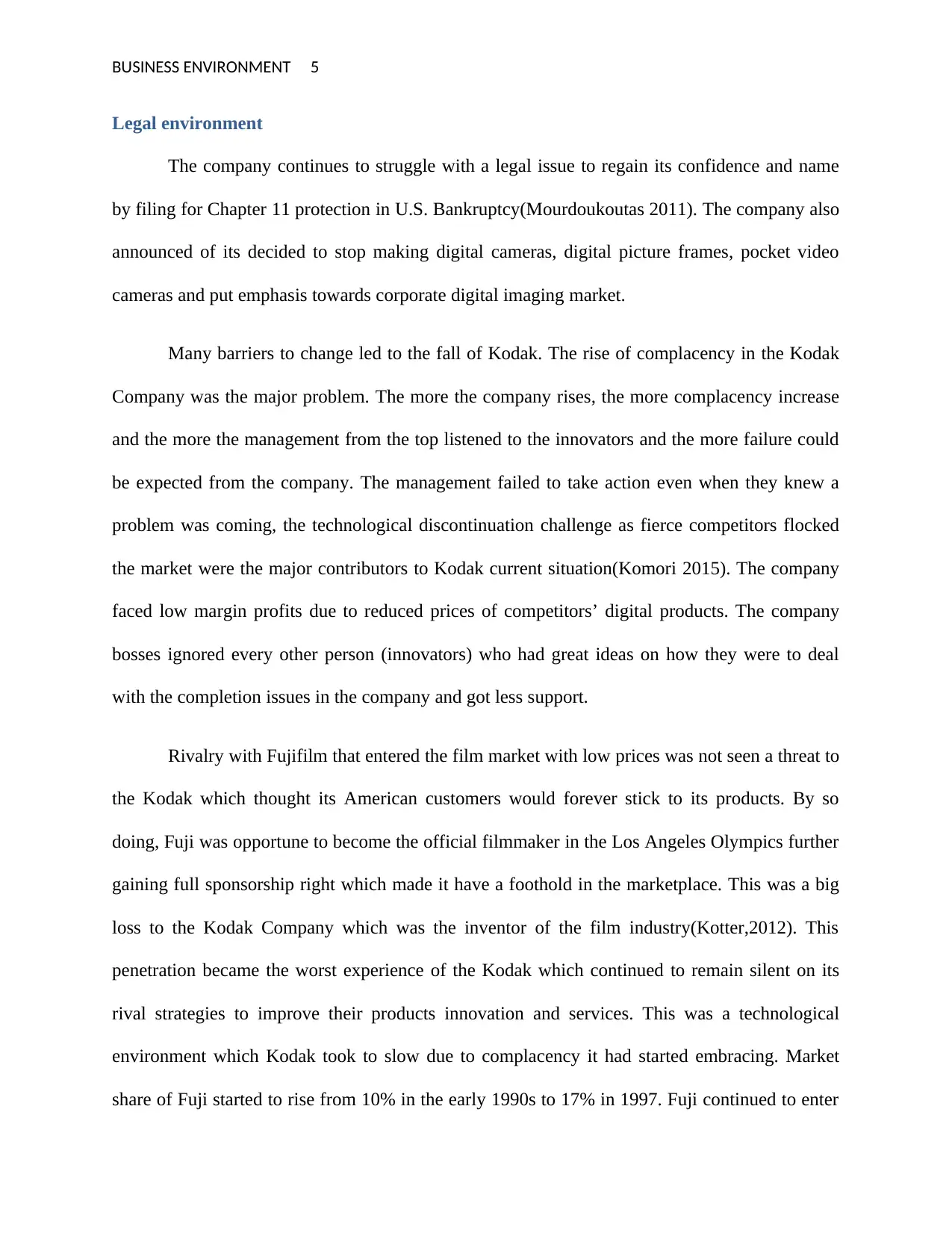
BUSINESS ENVIRONMENT 5
Legal environment
The company continues to struggle with a legal issue to regain its confidence and name
by filing for Chapter 11 protection in U.S. Bankruptcy(Mourdoukoutas 2011). The company also
announced of its decided to stop making digital cameras, digital picture frames, pocket video
cameras and put emphasis towards corporate digital imaging market.
Many barriers to change led to the fall of Kodak. The rise of complacency in the Kodak
Company was the major problem. The more the company rises, the more complacency increase
and the more the management from the top listened to the innovators and the more failure could
be expected from the company. The management failed to take action even when they knew a
problem was coming, the technological discontinuation challenge as fierce competitors flocked
the market were the major contributors to Kodak current situation(Komori 2015). The company
faced low margin profits due to reduced prices of competitors’ digital products. The company
bosses ignored every other person (innovators) who had great ideas on how they were to deal
with the completion issues in the company and got less support.
Rivalry with Fujifilm that entered the film market with low prices was not seen a threat to
the Kodak which thought its American customers would forever stick to its products. By so
doing, Fuji was opportune to become the official filmmaker in the Los Angeles Olympics further
gaining full sponsorship right which made it have a foothold in the marketplace. This was a big
loss to the Kodak Company which was the inventor of the film industry(Kotter,2012). This
penetration became the worst experience of the Kodak which continued to remain silent on its
rival strategies to improve their products innovation and services. This was a technological
environment which Kodak took to slow due to complacency it had started embracing. Market
share of Fuji started to rise from 10% in the early 1990s to 17% in 1997. Fuji continued to enter
Legal environment
The company continues to struggle with a legal issue to regain its confidence and name
by filing for Chapter 11 protection in U.S. Bankruptcy(Mourdoukoutas 2011). The company also
announced of its decided to stop making digital cameras, digital picture frames, pocket video
cameras and put emphasis towards corporate digital imaging market.
Many barriers to change led to the fall of Kodak. The rise of complacency in the Kodak
Company was the major problem. The more the company rises, the more complacency increase
and the more the management from the top listened to the innovators and the more failure could
be expected from the company. The management failed to take action even when they knew a
problem was coming, the technological discontinuation challenge as fierce competitors flocked
the market were the major contributors to Kodak current situation(Komori 2015). The company
faced low margin profits due to reduced prices of competitors’ digital products. The company
bosses ignored every other person (innovators) who had great ideas on how they were to deal
with the completion issues in the company and got less support.
Rivalry with Fujifilm that entered the film market with low prices was not seen a threat to
the Kodak which thought its American customers would forever stick to its products. By so
doing, Fuji was opportune to become the official filmmaker in the Los Angeles Olympics further
gaining full sponsorship right which made it have a foothold in the marketplace. This was a big
loss to the Kodak Company which was the inventor of the film industry(Kotter,2012). This
penetration became the worst experience of the Kodak which continued to remain silent on its
rival strategies to improve their products innovation and services. This was a technological
environment which Kodak took to slow due to complacency it had started embracing. Market
share of Fuji started to rise from 10% in the early 1990s to 17% in 1997. Fuji continued to enter
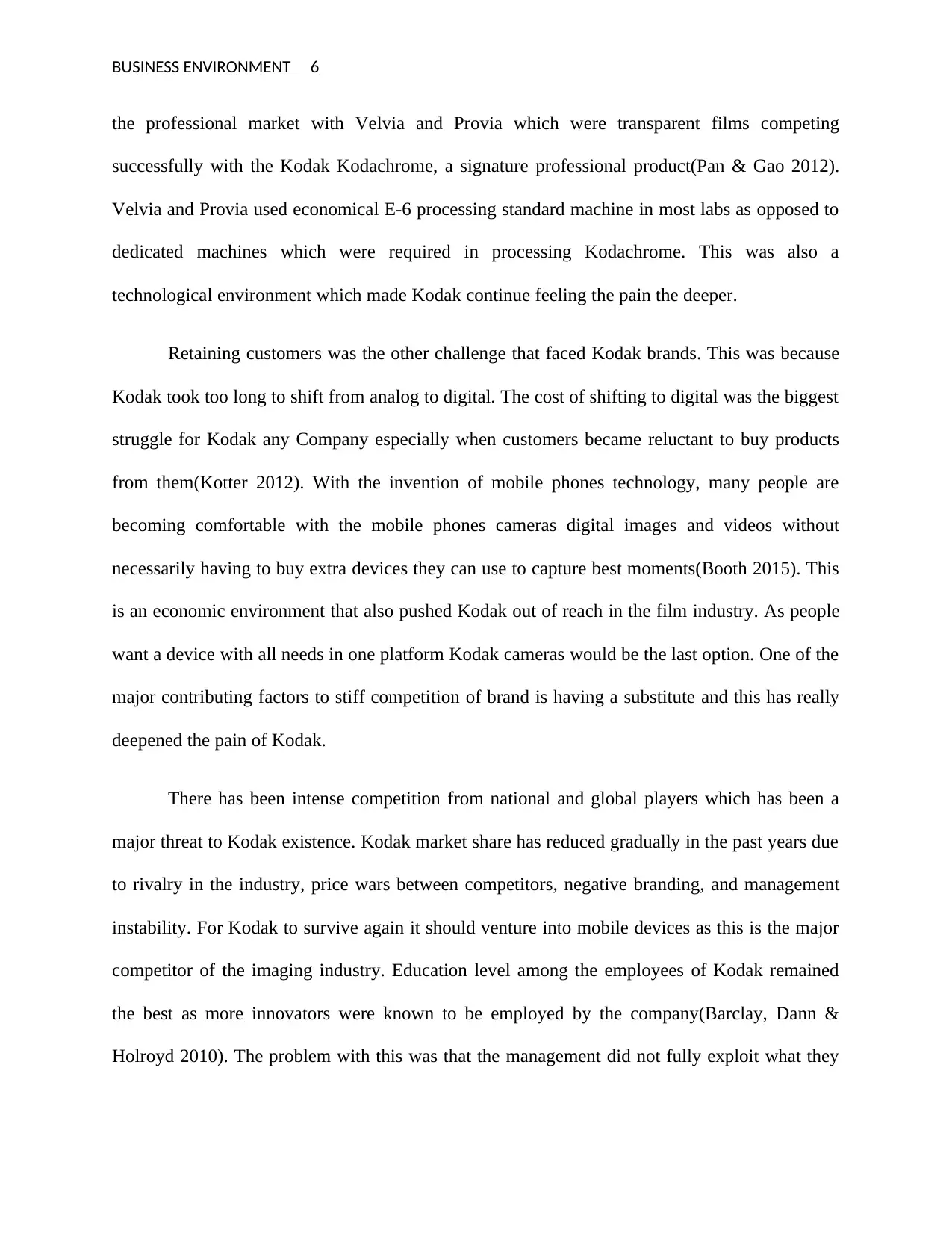
BUSINESS ENVIRONMENT 6
the professional market with Velvia and Provia which were transparent films competing
successfully with the Kodak Kodachrome, a signature professional product(Pan & Gao 2012).
Velvia and Provia used economical E-6 processing standard machine in most labs as opposed to
dedicated machines which were required in processing Kodachrome. This was also a
technological environment which made Kodak continue feeling the pain the deeper.
Retaining customers was the other challenge that faced Kodak brands. This was because
Kodak took too long to shift from analog to digital. The cost of shifting to digital was the biggest
struggle for Kodak any Company especially when customers became reluctant to buy products
from them(Kotter 2012). With the invention of mobile phones technology, many people are
becoming comfortable with the mobile phones cameras digital images and videos without
necessarily having to buy extra devices they can use to capture best moments(Booth 2015). This
is an economic environment that also pushed Kodak out of reach in the film industry. As people
want a device with all needs in one platform Kodak cameras would be the last option. One of the
major contributing factors to stiff competition of brand is having a substitute and this has really
deepened the pain of Kodak.
There has been intense competition from national and global players which has been a
major threat to Kodak existence. Kodak market share has reduced gradually in the past years due
to rivalry in the industry, price wars between competitors, negative branding, and management
instability. For Kodak to survive again it should venture into mobile devices as this is the major
competitor of the imaging industry. Education level among the employees of Kodak remained
the best as more innovators were known to be employed by the company(Barclay, Dann &
Holroyd 2010). The problem with this was that the management did not fully exploit what they
the professional market with Velvia and Provia which were transparent films competing
successfully with the Kodak Kodachrome, a signature professional product(Pan & Gao 2012).
Velvia and Provia used economical E-6 processing standard machine in most labs as opposed to
dedicated machines which were required in processing Kodachrome. This was also a
technological environment which made Kodak continue feeling the pain the deeper.
Retaining customers was the other challenge that faced Kodak brands. This was because
Kodak took too long to shift from analog to digital. The cost of shifting to digital was the biggest
struggle for Kodak any Company especially when customers became reluctant to buy products
from them(Kotter 2012). With the invention of mobile phones technology, many people are
becoming comfortable with the mobile phones cameras digital images and videos without
necessarily having to buy extra devices they can use to capture best moments(Booth 2015). This
is an economic environment that also pushed Kodak out of reach in the film industry. As people
want a device with all needs in one platform Kodak cameras would be the last option. One of the
major contributing factors to stiff competition of brand is having a substitute and this has really
deepened the pain of Kodak.
There has been intense competition from national and global players which has been a
major threat to Kodak existence. Kodak market share has reduced gradually in the past years due
to rivalry in the industry, price wars between competitors, negative branding, and management
instability. For Kodak to survive again it should venture into mobile devices as this is the major
competitor of the imaging industry. Education level among the employees of Kodak remained
the best as more innovators were known to be employed by the company(Barclay, Dann &
Holroyd 2010). The problem with this was that the management did not fully exploit what they
⊘ This is a preview!⊘
Do you want full access?
Subscribe today to unlock all pages.

Trusted by 1+ million students worldwide
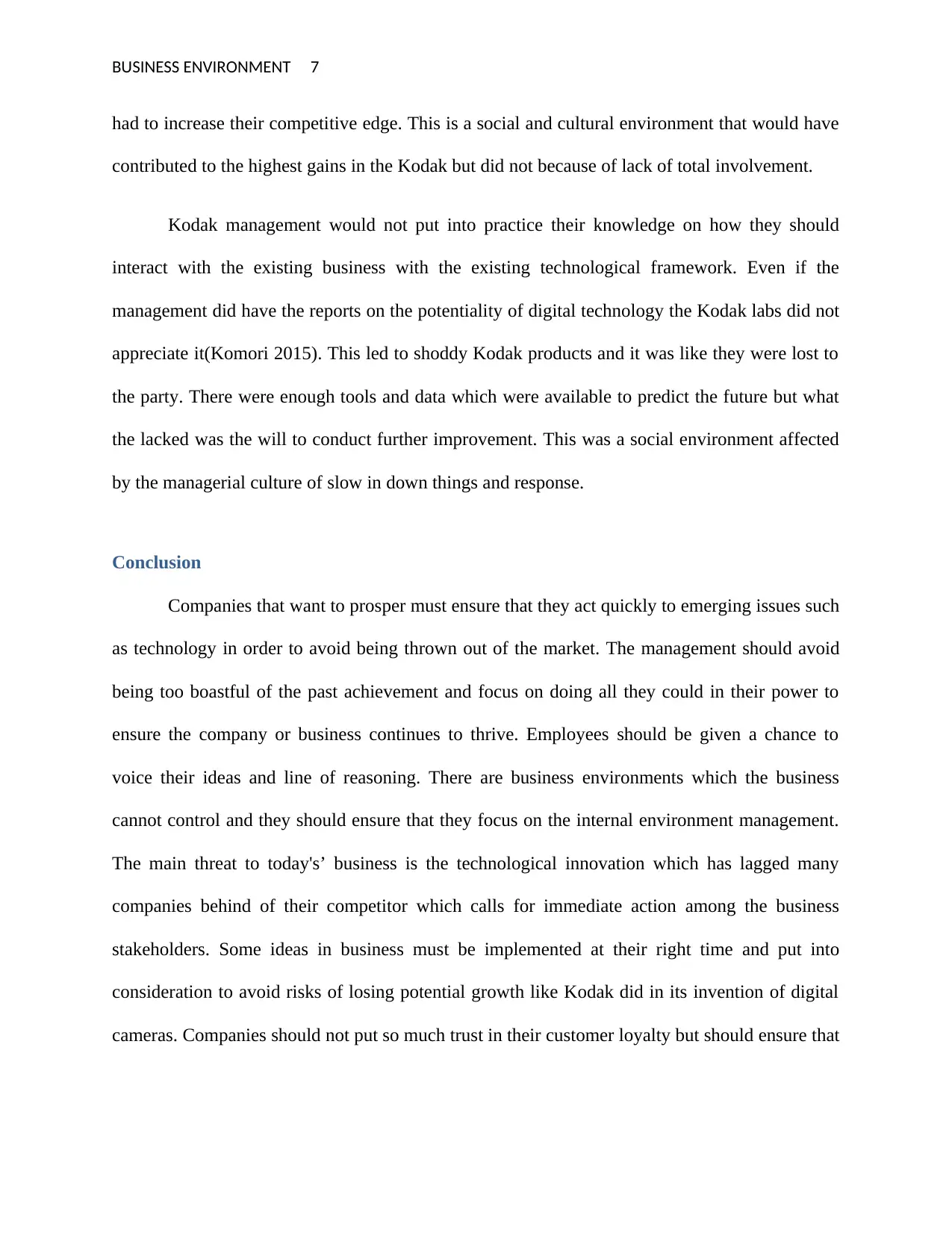
BUSINESS ENVIRONMENT 7
had to increase their competitive edge. This is a social and cultural environment that would have
contributed to the highest gains in the Kodak but did not because of lack of total involvement.
Kodak management would not put into practice their knowledge on how they should
interact with the existing business with the existing technological framework. Even if the
management did have the reports on the potentiality of digital technology the Kodak labs did not
appreciate it(Komori 2015). This led to shoddy Kodak products and it was like they were lost to
the party. There were enough tools and data which were available to predict the future but what
the lacked was the will to conduct further improvement. This was a social environment affected
by the managerial culture of slow in down things and response.
Conclusion
Companies that want to prosper must ensure that they act quickly to emerging issues such
as technology in order to avoid being thrown out of the market. The management should avoid
being too boastful of the past achievement and focus on doing all they could in their power to
ensure the company or business continues to thrive. Employees should be given a chance to
voice their ideas and line of reasoning. There are business environments which the business
cannot control and they should ensure that they focus on the internal environment management.
The main threat to today's’ business is the technological innovation which has lagged many
companies behind of their competitor which calls for immediate action among the business
stakeholders. Some ideas in business must be implemented at their right time and put into
consideration to avoid risks of losing potential growth like Kodak did in its invention of digital
cameras. Companies should not put so much trust in their customer loyalty but should ensure that
had to increase their competitive edge. This is a social and cultural environment that would have
contributed to the highest gains in the Kodak but did not because of lack of total involvement.
Kodak management would not put into practice their knowledge on how they should
interact with the existing business with the existing technological framework. Even if the
management did have the reports on the potentiality of digital technology the Kodak labs did not
appreciate it(Komori 2015). This led to shoddy Kodak products and it was like they were lost to
the party. There were enough tools and data which were available to predict the future but what
the lacked was the will to conduct further improvement. This was a social environment affected
by the managerial culture of slow in down things and response.
Conclusion
Companies that want to prosper must ensure that they act quickly to emerging issues such
as technology in order to avoid being thrown out of the market. The management should avoid
being too boastful of the past achievement and focus on doing all they could in their power to
ensure the company or business continues to thrive. Employees should be given a chance to
voice their ideas and line of reasoning. There are business environments which the business
cannot control and they should ensure that they focus on the internal environment management.
The main threat to today's’ business is the technological innovation which has lagged many
companies behind of their competitor which calls for immediate action among the business
stakeholders. Some ideas in business must be implemented at their right time and put into
consideration to avoid risks of losing potential growth like Kodak did in its invention of digital
cameras. Companies should not put so much trust in their customer loyalty but should ensure that
Paraphrase This Document
Need a fresh take? Get an instant paraphrase of this document with our AI Paraphraser
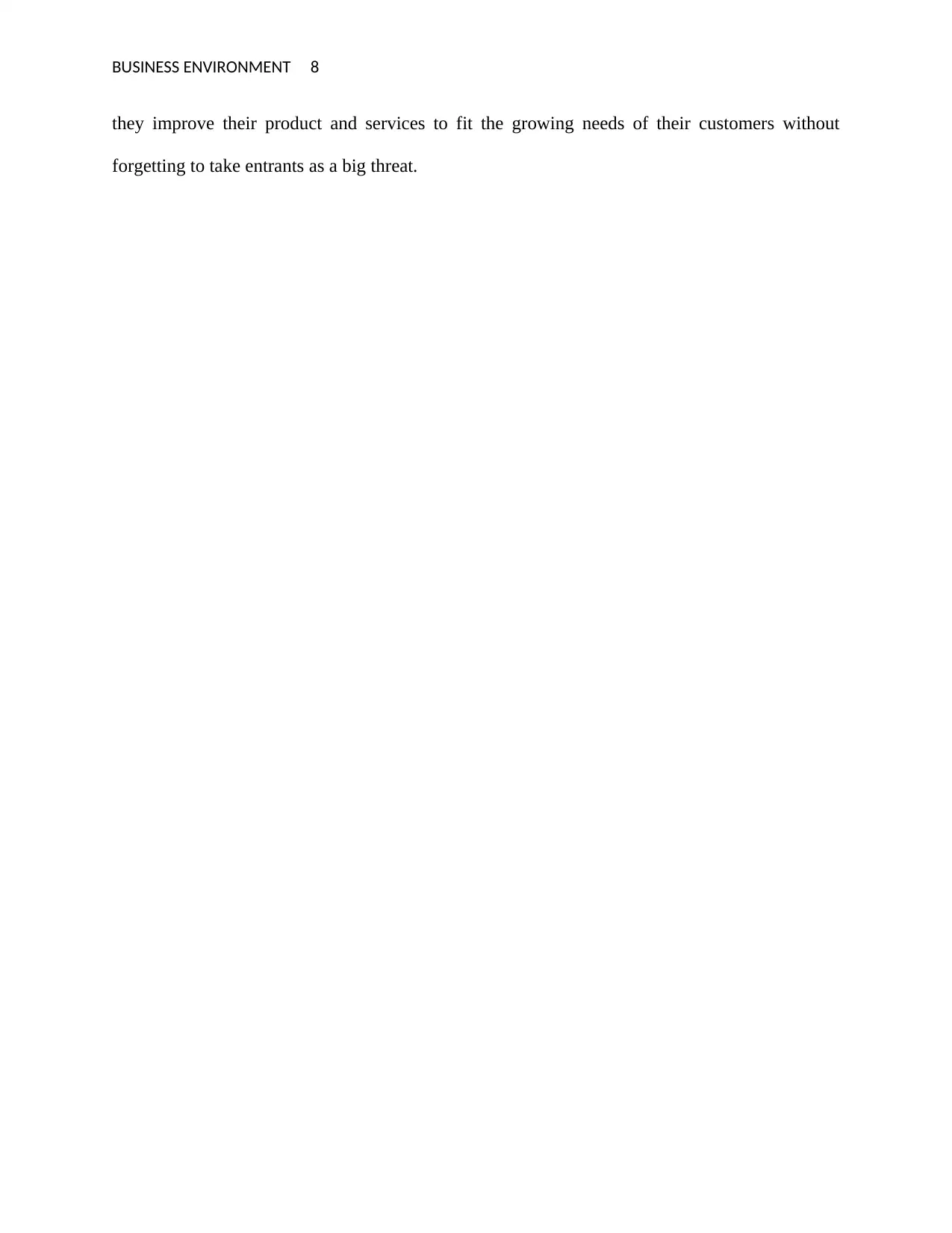
BUSINESS ENVIRONMENT 8
they improve their product and services to fit the growing needs of their customers without
forgetting to take entrants as a big threat.
they improve their product and services to fit the growing needs of their customers without
forgetting to take entrants as a big threat.

BUSINESS ENVIRONMENT 9
Reference
Barclay, I., Dann, Z., & Holroyd, P. (2010). New product development. Routledge.
Booth, S. A. (2015). Crisis management strategy: Competition and change in modern
enterprises. Routledge.
Cuthbertson, R., Furseth, P. I., & Ezell, S. J. (2015). Kodak and Xerox: How High-Risk
Aversion Kills Companies. In Innovating in a Service-Driven Economy (pp. 166-179).
Palgrave Macmillan, London.
Deaux, J., & Gara, A. (2013). Kodak: The end of an American moment. The Street.
Grant, R. M. (2016). Contemporary strategy analysis: Text and cases edition. John Wiley &
Sons.
Goldsborough, R. (2013). The changing world of photography. Tech Directions, 72(7), 12.
Komori, S. (2015). Innovating out of the crisis: How Fujifilm survived (and Thrived) as its core
business was vanishing. Stone Bridge Press, Inc.
Kotter, J. (2012). Barriers to change: The real reason behind the Kodak downfall. Forbes, May,
2.
Lau, W. V. (2014). Distressed Finance: Today and Tomorrow. In CFA Institute Conference
Proceedings Quarterly (Vol. 31, No. 1, pp. 12-17). CFA Institute.
Lucas Jr, H. C., & Goh, J. M. (2009). Disruptive technology: How Kodak missed the digital
photography revolution. The Journal of Strategic Information Systems, 18(1), 46-55.
Mourdoukoutas, P. (2011). The Entrepreneurial Failure of Eastman Kodak. Retrieved on April,
27.
Pan, J., & Gao, F. (2012). Kodak, Fight to Revive. SWOT Analysis and Strategy Plan.
Reference
Barclay, I., Dann, Z., & Holroyd, P. (2010). New product development. Routledge.
Booth, S. A. (2015). Crisis management strategy: Competition and change in modern
enterprises. Routledge.
Cuthbertson, R., Furseth, P. I., & Ezell, S. J. (2015). Kodak and Xerox: How High-Risk
Aversion Kills Companies. In Innovating in a Service-Driven Economy (pp. 166-179).
Palgrave Macmillan, London.
Deaux, J., & Gara, A. (2013). Kodak: The end of an American moment. The Street.
Grant, R. M. (2016). Contemporary strategy analysis: Text and cases edition. John Wiley &
Sons.
Goldsborough, R. (2013). The changing world of photography. Tech Directions, 72(7), 12.
Komori, S. (2015). Innovating out of the crisis: How Fujifilm survived (and Thrived) as its core
business was vanishing. Stone Bridge Press, Inc.
Kotter, J. (2012). Barriers to change: The real reason behind the Kodak downfall. Forbes, May,
2.
Lau, W. V. (2014). Distressed Finance: Today and Tomorrow. In CFA Institute Conference
Proceedings Quarterly (Vol. 31, No. 1, pp. 12-17). CFA Institute.
Lucas Jr, H. C., & Goh, J. M. (2009). Disruptive technology: How Kodak missed the digital
photography revolution. The Journal of Strategic Information Systems, 18(1), 46-55.
Mourdoukoutas, P. (2011). The Entrepreneurial Failure of Eastman Kodak. Retrieved on April,
27.
Pan, J., & Gao, F. (2012). Kodak, Fight to Revive. SWOT Analysis and Strategy Plan.
⊘ This is a preview!⊘
Do you want full access?
Subscribe today to unlock all pages.

Trusted by 1+ million students worldwide
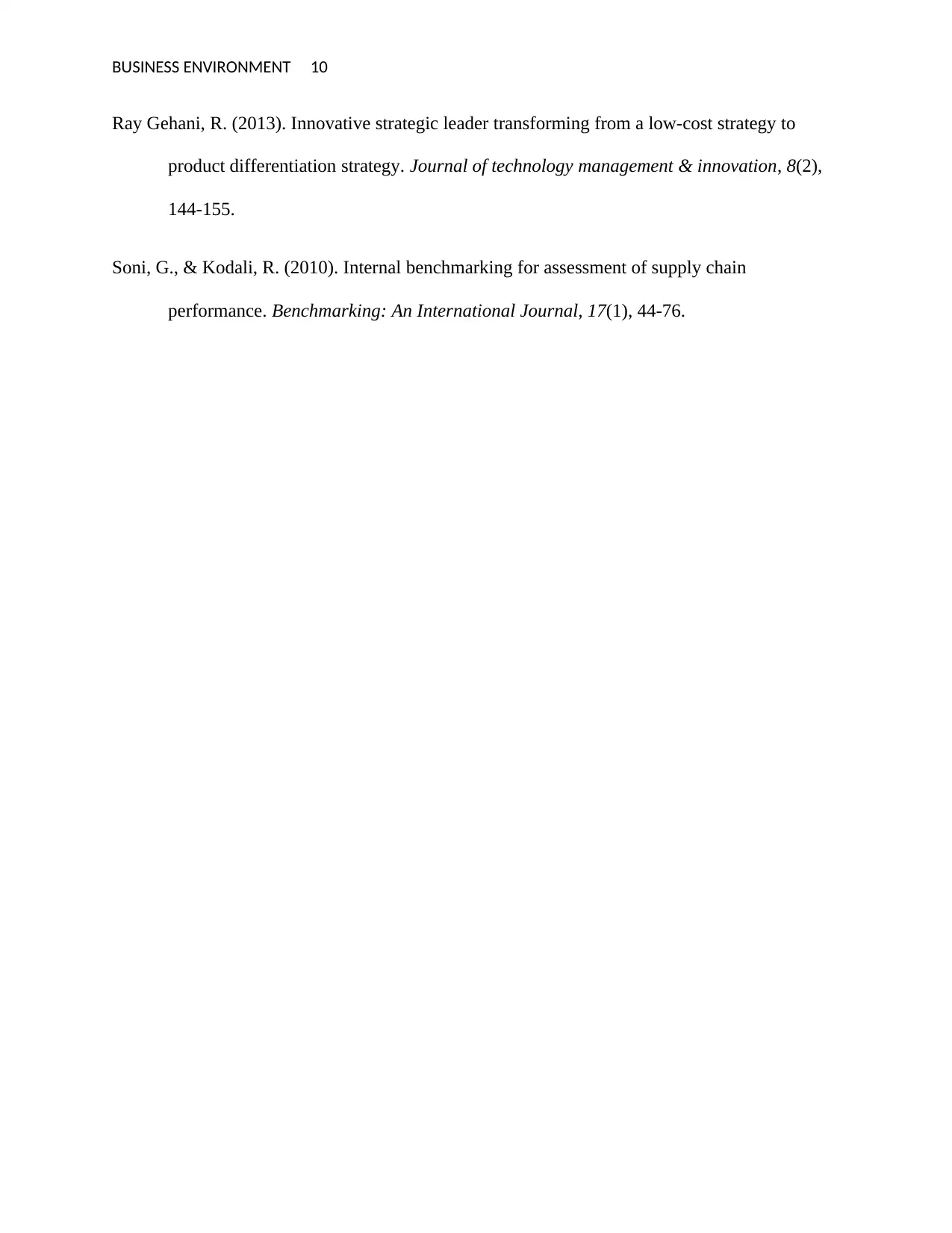
BUSINESS ENVIRONMENT 10
Ray Gehani, R. (2013). Innovative strategic leader transforming from a low-cost strategy to
product differentiation strategy. Journal of technology management & innovation, 8(2),
144-155.
Soni, G., & Kodali, R. (2010). Internal benchmarking for assessment of supply chain
performance. Benchmarking: An International Journal, 17(1), 44-76.
Ray Gehani, R. (2013). Innovative strategic leader transforming from a low-cost strategy to
product differentiation strategy. Journal of technology management & innovation, 8(2),
144-155.
Soni, G., & Kodali, R. (2010). Internal benchmarking for assessment of supply chain
performance. Benchmarking: An International Journal, 17(1), 44-76.
1 out of 10
Related Documents
Your All-in-One AI-Powered Toolkit for Academic Success.
+13062052269
info@desklib.com
Available 24*7 on WhatsApp / Email
![[object Object]](/_next/static/media/star-bottom.7253800d.svg)
Unlock your academic potential
Copyright © 2020–2025 A2Z Services. All Rights Reserved. Developed and managed by ZUCOL.




